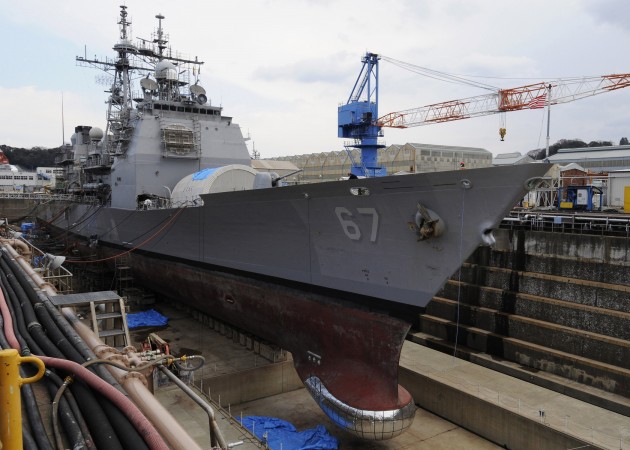HASC Rejects CNO Greenert Plea On Cruisers At Markup
Posted on

A Navy Aegis cruiser in drydock for a maintenance “availability.”
CAPITOL HILL: By 38 votes to 24, the House Armed Services Committee shot down a proposal to slow down its cruiser modernization plan. Offered by the top Democrat on the seapower subcommittee, Rep. Joe Courtney, the amendment stemmed from a request by the Chief of Naval Operations. In a letter sent to Congress yesterday, Adm. Jonathan Greenert said Congress’s plan to accelerate cruiser modernization would cost money the Navy can’t afford. “Read Adm. Greenert’s letter,” Rep. Courtney begged his colleagues:
Greenert has been in a cruiser tug-of-war with House seapower chairman Randy Forbes for years. The Navy has 22 aging Ticonderoga-class guided missile cruisers, whose Aegis radar and targeting system is more powerful than the version on the newer but smaller Arleigh Burke destroyers.
The Navy originally wanted to scrap seven of the ships outright. When Congress rejected that, the Navy came back with a plan to keep 11 in service — one to escort each aircraft carrier in the fleet — and put the other 11 in a slow-motion modernization process, from which they would emerge as the unmodernized cruisers retired. Congress said that was too slow and legislated less year that no ship could spend more than four years in modernization, part of the so-called 2-4-6 plan. In this year’s draft bill, Forbes tightened that period to just two years, aka 2-2-6.
Greenert writes taht the accelerated 2-2-26 plan would save the Navy no money at all, compared to $300-400 million under the current 2-4-6 law and $4.5 billion under the Navy’s slo-mo mod proposal. By returning ships to service faster, it would also use up their service life sooner, with the last Ticonderoga leaving the fleet in 2035, as opposed to 2038 under the current plan and sometime in the 2040s under the Navy’s.
That all sounds nice, responded Rep. Forbes, if you believe the Navy. But the Navy has no funding set aside for modernization in its future years defense plan (FYDP), he said, which proves they aren’t serious. Modernization on the Navy’s terms is really mothballing, the seapower chairman said.
“If they were serious about this they would put the funding in the FYDP. They did not do that,” Forbes growled at the subcommittee mark-up today. “If we let those cruisers go in there for that 2-4-6 program, we’ll never see these cruisers in service again.”
“The question is whether we just let the navy run the clock out,” Forbes said. If Congress doesn’t push hard, with the force of law, ships will go into “modernization” only for the Navy to come back a few years later and say, oops, we don’t have money to do this, guess we’ll have to scrap them after all — a backdoor way of getting what the Navy originally wanted.
Forbes’ stance speaks to the deep distrust he and many Republicans have towards this administration. The response from the committee’s ranking Democrat speaks to how deep the difference is in party perspectives. The cruiser retirement is budget-driven, said Rep. Adam Smith, and we’ll keep facing such lesser-of-two-evils choices as long as Congress fails to repeal the Budget Control Act, aka sequester. (Playing “games” with Overseas Contingency Operations (OCO) funding doesn’t count as a sequester fix, Smith said).
“It’s early in this [markup] to start a fight, but I’ll mention the word taxes,” Smith said. “If we’re really absolutely committed to providing the national security that we need, providing the cruisers that we need, we could, God forbid, raise revenue and actually pay for it. But since we’re not doing that, the Department of Defense and in this case the Department of the Navy is scrambling.”
Subscribe to our newsletter
Promotions, new products and sales. Directly to your inbox.
